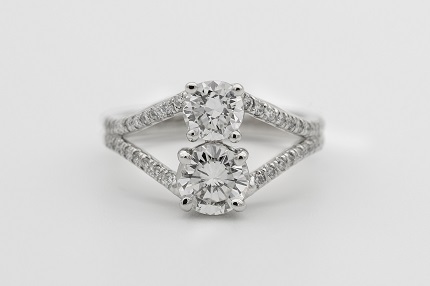Before the discovery of diamonds in Brazil in the 1720s, most diamonds came from India, and we were the world’s principal producer of diamonds for over 1000 years
It is a well-known fact that India has a long-established connection with diamonds, not since years, but centuries. Before the discovery of diamonds in Brazil in the 1720s, most diamonds came from India, and we were the world’s principal producer of diamonds for over 1000 years. As the Indian mines depleted, India’s control over the trade became restricted to its strong manufacturing capabilities, and right till today, over 95% of the diamonds worldwide are cut and polished in India.
However, times are changing again for India. With the rising popularity of lab-grown diamonds across the world, and India being the world’s leading producer of Type IIa CVD diamonds, we are regaining our claim to fame of being the world’s leading producer of the finest quality diamonds.
Thanks to the CVD (Carbon Vapor Deposition) technology that is indigenously developed and completely made in India, we are now emerging as a global hub of not just manufacturing, but also diamond production.

Bain & Co’s recent Diamond Industry Report 2021 reveals that global lab-grown diamond production has crossed 7 million carats per year. Of this, India is leading the charts in CVD diamond production of almost 1.5 million carats each year, higher than the overall production levels even in USA, Europe, the Middle East, Russia and Singapore.
These huge production volumes have translated into rapid growth in export collections. As reported by the Gems and Jewellery Export Promotion Council (GJEPC), polished lab-grown diamond exports nearly doubled to Rs5,175 crore for FY2021, compared to Rs 2,985 crore last year.
Leading the evolution of the lab-grown diamond industry in India is Bakul Limbasiya, the leading technocrat to have developed the CVD diamond technology in India, and responsible for nearly 80% of the 1.5 million carats produced domestically.
Commonly known as the Bhishma pitamah (originator or creator) of the lab-grown diamond industry in India, Limbasiya has been instrumental in shaping the domestic lab-grown industry. Having produced scalable volumes, he has been successful in proving that India can emerge from being just a manufacturing hub to becoming one of the largest producers of diamonds, that too those of the finest quality.
“This is just the beginning for India. FY ’21 yet again proved to be a robust year for the Indian lab-grown industry, with exports up 74% y/y, crossing Rs 5,000 crore in value. Going forward, the industry will see an even stronger growth in exports as global economies recover and consumer demand picks up. And India will have a huge role to play in further shaping the industry worldwide, not only because of its increasing capacity to manufacture CVD diamonds, but also because of its huge consumption potential, with the largest millennial population,” says Limbasiya.
As per a Frost & Sullivan report published in 2015, due to limitation of resources, mined diamond supply will decline to 62m carats by 2030, while the demand will increase, leaving a deficit of nearly 160m carats.

Limbasiya sees this huge gap between demand for rough diamonds and the depleting supply of mined diamonds as an opportunity to be filled with lab-grown CVD diamonds in ten years. With India as a leading producer and exporter of CVD diamonds today, it stands to gain from this situation.
Lab-grown diamonds - New choice of the conscious millennial
While lab-grown diamonds are 100% real and a more affordable option, the fact that these diamonds best align with the values of today’s consumer is what sets them leagues apart from traditional stones. Those opting for lab-grown diamonds are also making sure that they not only pass on a precious heirloom to future generations, but also a planet that is ecologically diverse and lively.
Interestingly, lab-grown diamonds have the highest demand from millennials, and historically, millennials have been the largest purchasers of mined diamonds. With the ever-increasing environmental threats and depletion of mines, consumers have been quite wary of purchasing diamonds. They now focus not only on aesthetics and rarity in their jewels, but also seek assurances that the diamonds have been sourced responsibly. These values have led to an increased demand for non-mined diamonds, and the demand is expected to grow.
This preferential shift towards lab-grown diamonds is now reflecting in the increasing lab-grown sales in the mined-diamond-dominant markets, such as USA and China. India too is not behind, and is catching pace swiftly, with Indian millennials also beginning to embrace lab-grown diamonds. With a millennial population of over 40crore, the highest in the world, and its increasing support for sustainable and eco-friendly products, a boost in the domestic demand for lab-grown diamond-studded jewellery is inevitable.
Leading the lab-grown diamond initiative in the consumer space is Limelight Lab Grown Diamonds, India’s largest luxury brand offering sustainable CVD diamond-studded jewellery. With over 10 retail partners across Hyderabad, Kolkata, Ahmedabad, Mumbai and Goa, and 15 associate partners, the brand continues to penetrate strongly in the Indian jewellery market.

“Awareness about lab-grown diamonds is spreading fast in India. Consumers are now more educated about these real non-mined diamonds. And contrary to common industry beliefs, with increasing awareness, consumers are also becoming more comfortable with the co-existence of lab-grown diamonds with their mined counterparts. The unique and independent personality of lab-grown diamonds as sustainable and environment-friendly, yet affordable gemstones, is extremely well-accepted among millennial consumers, and is increasingly reflecting in the sales of lab-grown diamond-studded jewellery across India,” says Pooja Sheth, MD and Founder, Limelight.
Birth of a lab-grown diamond
Lab-grown diamonds are absolutely real, and, at the same time, planet-friendly, because they are not mined, but instead, grown in labs in exactly the same way as they would have formed beneath the surface of the earth. They have the same carbon composition, properties and characteristics and they leave the earth free of mining manipulations. As a result, these diamonds are conflict-free and eco-friendly, and help sustain the earth’s depleting resources, particularly land and water.
There are two ways to grow a lab-grown diamond - Chemical Vapor Deposition (CVD process) and the High Pressure High Temperature (HPHT) process.
The CVD process is an advanced technology, largely developed in India, that replicates the diamond formation process from below the earth. This is equivalent to the concept of IVF technology and test tube babies, where the DNA remains the same, but the formation environment is different.
The process begins with a mined diamond. A thin layer of the mined diamond is prepared and placed as a seed in the CVD plasma reactor. An intense temperature and pressure environment is created, just like that found below the earth. Gases are infused, and under severe conditions, carbon disintegrates to form rough diamonds. These are then removed from the plasma reactors and cut and polished in exactly the same manner as a mined diamond.
But the main significance of a CVD diamond is that it is composed of 100% carbon and is nitrogen-free. World-renowned diamond grading and certifying labs classify such diamonds as a Type IIa diamond. The shine and brightness of these diamonds is significantly better than that of any other diamond.
This is impossible to achieve through the HPHT process, and it is extremely rare to find this quality in mined diamonds. As many as 98% of mined diamonds have nitrogen impurities, and only 2% of the world's mined diamonds are 100% carbon-composed and classified as Type IIa.
All diamonds formed through the CVD process are composed entirely of carbon and receive the Type IIa classification from the certifying bodies. As a result, the shine and brilliance of a CVD diamond is unmatched and rare to find in its mined counterparts.
On the other hand, the High Pressure High Temperature (HPHT) process, largely developed in China, uses graphite and a molten metal influx to form a diamond under severe temperature and pressure conditions. With impurities of metal in the diamond, HPHT diamonds are never 100% carbon-composed, and cannot be classified as Type IIa.
Be the first to comment